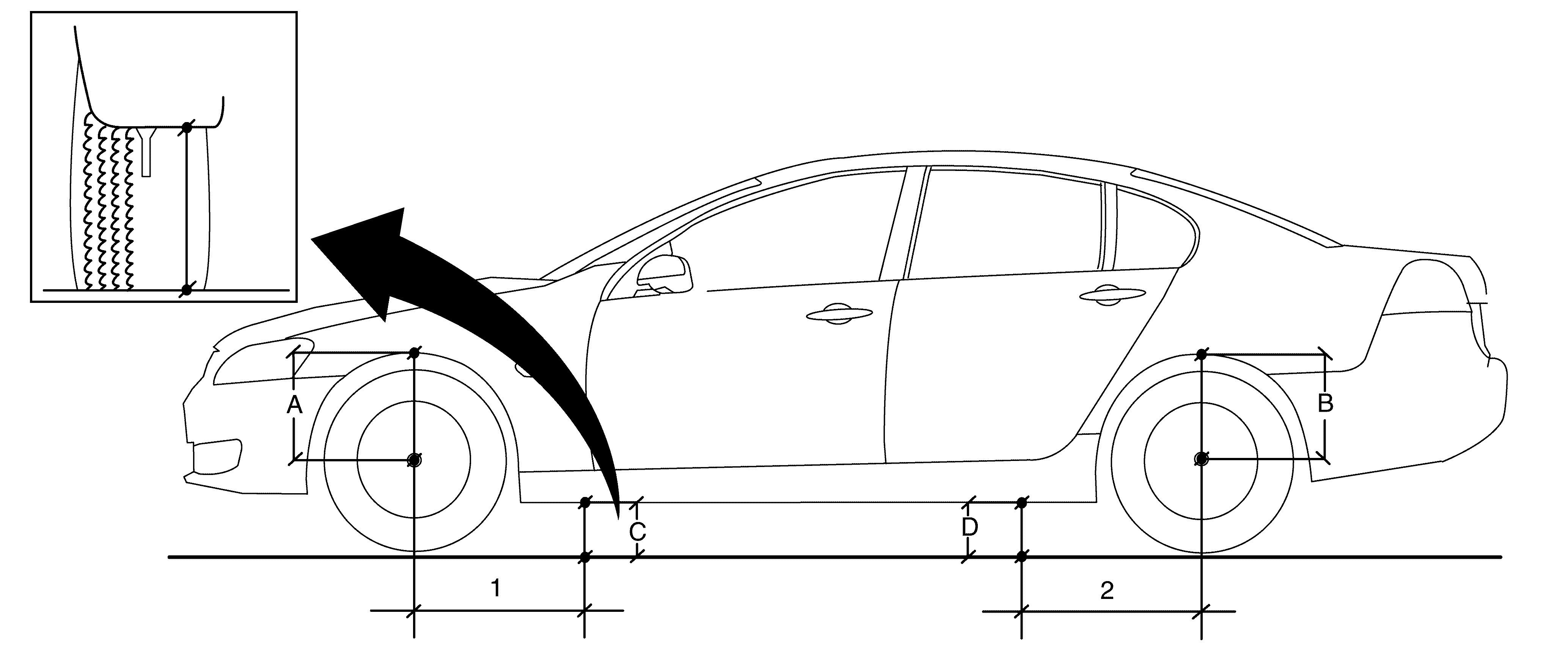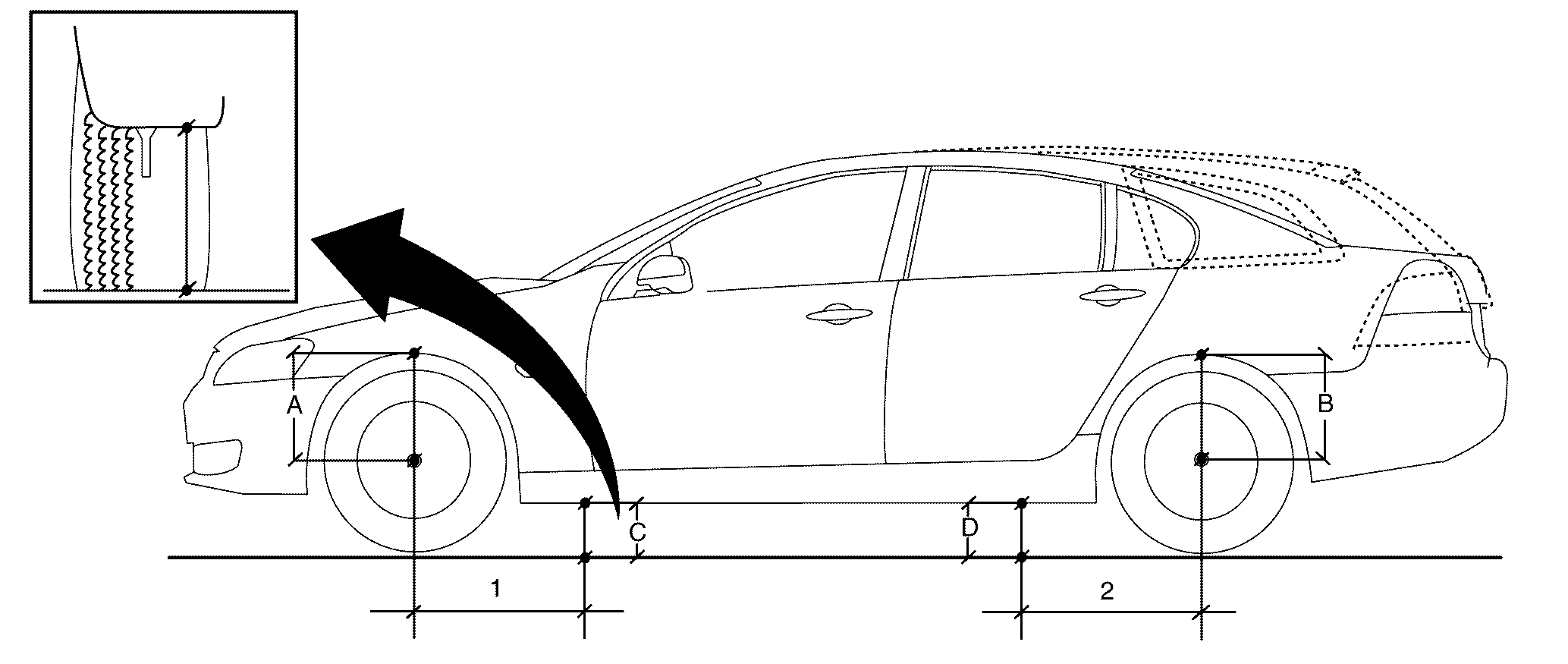Trim Height Inspection SWB
Trim Height Measurement
Trim height is a predetermined measurement relating to vehicle ride height.
Incorrect trim heights can cause the vehicle to bottom out over bumps causing damage
to the suspension components and symptoms similar to wheel alignment concerns. Check
the trim heights when diagnosing suspension concerns and before checking the wheel
alignment.
The vehicle must be on a flat level surface and all dimensions must be measured
vertical from the ground. Trim heights should be within 13 mm (0.51 in)
to be considered correct.
The suspension and trim height dimensions are for standard vehicles with base
equipment only. The dimensions are for a new vehicle built to standard specification
and are intended as a guide when checking trim height dimensions at normal kerb weight.
Perform the following before measuring the trim heights:
| • | Check the fuel level. Add additional weight if necessary to simulate a
full tank. |
| • | Make sure the passenger and rear compartments are empty, except for the
spare tyre. |
| • | Make sure the vehicle is on a flat and level surface, such as an alignment
rack. |
| • | Check that all the vehicle doors are securely closed. |
| • | Check that the vehicle hood and trunk are securely closed. |
| • | Check for installed after market accessories or modifications that could
affect trim height measurement. |
Measuring the trim height

Important: The vehicle must be on a flat level surface
- Using your hands, lift the front bumper approximately 38 mm (1.49 in).
- Gently remove your hands and allow the vehicle to lower.
- Using your hands, bounce the front of the vehicle downward approximately
38 mm (1.49 in).
- Gently remove your hands and allow the vehicle to rise.
- Measure and note the C dimension for the left and right side of the vehicle,
inboard of the pinch-weld flange at 544 mm (21.42 in) (1) from the centreline
of the front wheel.
- Measure and note the A dimension for the left and right side of the vehicle
from the bottom of the front wheel rim to the wheel arc along the centreline of the
front wheel.
- Using your hands, lift the front bumper approximately 38 mm (1.49 in).
- Gently remove your hands and allow the vehicle to lower.
- Using your hands, bounce the front of the vehicle downward approximately
38 mm (1.49 in).
- Gently remove your hands and allow the vehicle to rise.
- Measure and note the D dimension for the left and right side of the vehicle,
inboard of the pinch-weld flange at 544 mm (21.42 in) (1) from the centreline
of the rear wheel.
- Measure and note the B dimension for the left and right side of the vehicle
from the bottom of the rear wheel rim to the wheel arc along the centreline of the
rear wheel.
- Compare the A, B, C and D dimension measurements to the trim height specifications.
Refer to
Trim Height Specifications
.
- Compare the right and left and front and rear dimension measurements to
the trim height variation specifications. Refer to
Trim Height Specifications
.
- If the measurements are not within the specified range, replace the coil
springs as required. Refer to
Coil Spring Replacement
or
Coil Spring Replacement
.
Trim Height Inspection Sportwagon
Trim Height Measurement
Trim height is a predetermined measurement relating to vehicle ride height.
Incorrect trim heights can cause the vehicle to bottom out over bumps causing damage
to the suspension components and symptoms similar to wheel alignment concerns. Check
the trim heights when diagnosing suspension concerns and before checking the wheel
alignment.
The vehicle must be on a flat level surface and all dimensions must be measured
vertical from the ground. Trim heights should be within 13 mm (0.51 in)
to be considered correct.
The suspension and trim height dimensions are for standard vehicles with base
equipment only. The dimensions are for a new vehicle built to standard specification
and are intended as a guide when checking trim height dimensions at normal kerb weight.
Perform the following before measuring the trim heights:
| • | Check the fuel level. Add additional weight if necessary to simulate a
full tank. |
| • | Make sure the passenger and rear compartments are empty, except for the
spare tyre. |
| • | Make sure the vehicle is on a flat and level surface, such as an alignment
rack. |
| • | Check that all the vehicle doors are securely closed. |
| • | Check that the vehicle hood and trunk are securely closed. |
| • | Check for installed after market accessories or modifications that could
affect trim height measurement. |
Measuring the trim height

Important: The vehicle must be on a flat level surface
- Using your hands, lift the front bumper approximately 38 mm (1.49 in).
- Gently remove your hands and allow the vehicle to lower.
- Using your hands, bounce the front of the vehicle downward approximately
38 mm (1.49 in).
- Gently remove your hands and allow the vehicle to rise.
- Measure and note the C dimension for the left and right side of the vehicle,
inboard of the pinch-weld flange at 544 mm (21.42 in) (1) from the centreline
of the front wheel.
- Measure and note the A dimension for the left and right side of the vehicle
from the bottom of the front wheel rim to the wheel arc along the centreline of the
front wheel.
- Using your hands, lift the front bumper approximately 38 mm (1.49 in).
- Gently remove your hands and allow the vehicle to lower.
- Using your hands, bounce the front of the vehicle downward approximately
38 mm (1.49 in).
- Gently remove your hands and allow the vehicle to rise.
- Measure and note the D dimension for the left and right side of the vehicle,
inboard of the pinch-weld flange at 544 mm (21.42 in) (1) from the centreline
of the rear wheel.
- Measure and note the B dimension for the left and right side of the vehicle
from the bottom of the rear wheel rim to the wheel arc along the centreline of the
rear wheel.
- Compare the A, B, C and D dimension measurements to the trim height specifications.
Refer to
Trim Height Specifications.
- Compare the right and left and front and rear dimension measurements to
the trim height variation specifications. Refer to
Trim Height Specifications.
- If the measurements are not within the specified range, replace the coil
springs as required. Refer to
Coil Spring Replacement or
Coil Spring Replacement.


